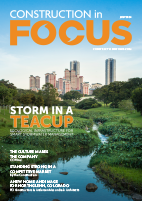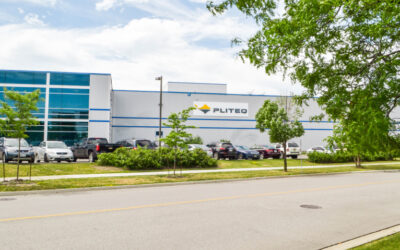Many of us are concerned about the environment and reducing our carbon footprint, but David Sands has made the future of the planet his life’s work. A meeting between carpenter Jeffree Trudeau and architect Sands on the Island of Maui in 1994 led the two to realize there had to be a better, more sustainable, and earth-friendly way to build—and it was with bamboo.
This soon led to the construction of a community house out of bamboo, the founding of Bamboo Living in 1995, and the creation of the world’s first certified, permit-ready International Code Council (ICC) compliant bamboo buildings and homes.
On the threshold of Bamboo Living’s 30th anniversary, co-founder and Chief Architect Sands reflects on the company’s many success stories and the future use of bamboo, Earth’s most sustainable building material. Sands’ encyclopedic knowledge of bamboo’s many benefits as a construction material and its role in sequestering carbon shine through.
Bamboo benefits
Growing primarily in tropical and subtropical areas, bamboo is not a wood but a member of the grass family. Abundant in southeastern Asia, bamboo plants range in height from stiff reeds of about three feet (one meter) to neck-craning giants of about 160 feet (48.8 m) in height and 12 inches (30 cm) in diameter.
With stems that develop underground from thickened plant stems called rhizomes, new shoots grow slowly at first, but can increase to about two feet (60 cm) of growth per day.
Thanks to its turbo-charged growth rate, bamboo has been used by humans for centuries for everything from woven baskets, huts, hats, and mats to fishing rods and fish traps. And because of its superior strength-to-weight ratio, bamboo is also ideal for building scaffolding, rafts, bridges, and even entire buildings, as Sands and his team have shown time and time again.
With bamboo offering the same tensile strength as mild steel at a fraction of the weight, homes and other structures from Bamboo Living are engineered to withstand even hurricane-force winds. Durable, functional, and attractive, sustainably harvested bamboo, when made into houses or properly treated building materials, creates “an effective carbon capture and storage system,” according to the company, with embodied CO2 being stored for an incredible 150 years.
“By not cutting trees, it’s part of the climate solution, and the buildings are the storage mechanisms for the CO2,” explains Sands. “Every ton of bamboo building material locks up about 1.83 tons of CO2. There’s more CO2 locked up in a ton of bamboo than the weight of the bamboo.”
The harvesting of trees and bamboo stand in sharp contrast to one another. When trees are chopped down, the entire tree is killed. Only about 50 percent of the above-ground biomass is used, yet the below-ground biomass also dies. When bamboo is cut, the plant survives, keeps growing, and remains functional in offering a high level of carbon sequestration and storage.
“You’re basically pruning the bamboo every year,” notes Sands. “It has a different growth pattern from the tree, and you’re not killing the bamboo, you’re stimulating further growth.”
The bamboo can-do story
Having designed and constructed more than 400 bamboo homes, Bamboo Living is broadening its base, demonstrating the many applications of this sustainable building material.
Sister company Rizome—which cultivates and manufactures engineered bamboo lumber—recently designed and built a 75’ x 25’ x 17’ (22.5m x 7.6m x 5m), two-story engineered bamboo building. Located in Manila, Philippines, the Rizome Miracle Pavilion was part of a major pop-up art festival that drew about 40,000 visitors.
“It’s the biggest art festival in the Philippines,” says Sands. “They take over a parking garage, and on top of it they showcased [our bamboo pavilion].” Featuring bamboo’s beauty and durability as a construction material, the impressive structure was the size of a PBA (Philippine Basketball Association) basketball court. It was designed by top architect Andy Locsin.
Boasting super-engineered bamboo columns, the steel-free Miracle Pavilion was described by the company as “an architectural masterpiece that embodies the transformative potential of Rizome Bamboo in contemporary construction, where each component, from robust columns to resilient beams and framework, showcases the unparalleled stability and versatility inherent in Rizome’s bamboo engineering.”
Last year, Sands and Rizome created a nonstructural treatment with curved walls that formed the social spaces; this year, they created the rooftop pavilion which housed the dining and nightclub areas. “And it showcased the lumber, because it had 25-foot spans of the material which were quite thin, only two inches wide by twelve inches deep,” says Sands. “If that was regular lumber, it would have bowed, but it was just beautiful.”
Another advantage of the structure’s design is the speed of assembly, which took about two days. Sections were used for the annual convention of the FICCO credit union (also an investor in Bamboo Living), with assembly taking just a few hours. Other components became part of a building materials and interior design showcase.
Next, the company is embarking on a four-story building and is working on the first hybrid skyscraper. Slated to be 40 to 50 stories, the skyscraper will be a combination of concrete and bamboo mass timber.
Growing anew
As Bamboo Living’s co-founder and Chief Architect and Rizome’s Chief Design Officer and Director, Sands is often called upon to discuss the many uses of bamboo in the construction industry. Presenting at conferences in Bali in March and at another in Taiwan in April, Bamboo Living is also engaged in conversations with the Nature Conservancy of Asia about working on a pilot project together. And the company will find out if it made the Top 20 in the final round of the Carbon Removal XPrize on Earth Day, April 22nd.
“It’s all part of the climate solution associated with bamboo, and an important piece of the puzzle,” says Sands. “When I ran the numbers out for XPrize, the conversion of 12 percent of global construction materials to bamboo addresses about a third of human emissions. Wood, concrete, and steel are about 25 percent of emissions.”
Unlike trees, which take decades to mature before harvesting, bamboo is the fastest-growing woody plant on the planet. To maintain a high level of sequestration, bamboo needs to be cropped every year. That material is then turned into building materials, alternative fuels for electricity generation, and then biochar, organic materials carbonized by high temperatures. Representing long-term storage of carbon, biochar is then used for large-scale planting projects.
Presently, the company is working with the Asian Development Bank on financing for millions of acres of deforested land in need of reforestation. With 1.3 million bamboo plants in the Philippines, Rizome has also planted some acreage in Florida and is looking for financing to effect large-scale planting in the state.
“We’ve got a Fortune 100 Company talking to us about large-scale planting for offsetting their carbon, so that’s pretty exciting,” says Sands. In the future, he sees bamboo playing an even bigger role as both a sustainable construction material and a valuable tool in fighting the climate crisis.
Previously, Bamboo Living’s Indigenous partners in the Philippines saw much of their ancestral domain logged over, and there are grasslands where forests used to be. By planting bamboo, they are generating income for their tribal members and creating an asset that will continue to be harvested by their grandchildren.
“They own the plants that are being planted, and it’s part of their ancestral domain now,” says Sands. “They’re rebuilding that forest.”
Presently in conversations with the Nature Conservancy about planting bamboo on an even larger scale once funding is in place, Sands expects the nursery to make between five million and eight million bamboo plants by the end of this year.
“An Indigenous woman leads the biggest nursery and planting program. We’re addressing all 17 of the United Nations Sustainable Development Goals, and we’re helping keep the peace in a former area of conflict,” shares Sands. “Bamboo has so many positive implications, all the way back to the most remote villages. It is incredible.”













